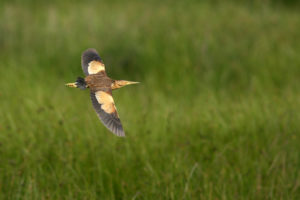Flight calls of Eurasian Bittern are more commonly heard in East Germany than those of Little Bittern, or at least there are more reports of them. Many know the typical graow (it rhymes with “cow”) from birds flying around in the breeding grounds or from nightly transits over rural areas. The NFC is markedly low-pitched, although not as extreme as Eurasian Bittern’s booming. It will usually linger or resonate around 1 kHz (mean frequency 1.1 kHz, n = 101). This means if the recording is not good enough you will often face the difficulty of separating it from a distant dog’s bark or, for this very reason, you may overlook it.
Eurasian Bittern Botaurus stellaris, Potsdam, Germany, 03:29, 8 August 2016 (Lukas Pelikan). Graow calls of a bird flying relatively close to the microphone, at 0:02, 0:37, 1:09 and 1:30. Background: funnily enough there is an Ortolan Bunting Emberiza hortulana migrating too, giving two plik calls from 1:16.
The shape of Eurasian Bittern’s call is almost exclusively a smooth arch. Just as in Little Bittern’s call there is usually an emphasis on the descending part. So you should hear something going down at the end of the call, indeed very similar to the word “cow” or the diphthong “aʊ”. Variation of the shape of the call seems to be rather limited. Since this call is at the lower end of the frequency spectrum, the sonagram must be stretched along the frequency axis (ie, vertically) to see minor differences in shape.
Eurasian Bittern Botaurus stellaris. Five variations of graow call. 1) and 2) Potsdam, Germany, 03:29, 8 August 2016 (Lukas Pelikan), 3) and 5) Khalkhgol, Dornod, Mongolia, 01:17, 23 August 2017 (Steve Klasan), 4) Trebelsee, Havelland, Germany, 19:30, 25 February 2015 (Bert Jahnke).

Another confusion risk for Eurasian Bittern’s graow is the flight calls of larger gulls, especially those of Pallas’s Gull Larus ichthyaetus and Great Black-backed Gull L marinus. These also rhyme with “cow” or “aʊ” and are low-pitched. They will usually be followed by different, more unmistakeably gull-like calls with much more variation, excluding Eurasian Bittern instantly. When looking at a single call, a very good starting point is to look for the harmonics: in flight calls of gulls the additional frequency bands of one call should each show similar power, whereas in Eurasian Bittern there should be an arch carrying the main power and several clearly less powerful frequency bands above or below. And finally, if you have additional croakiness blurring the call this should exclude a gull.

